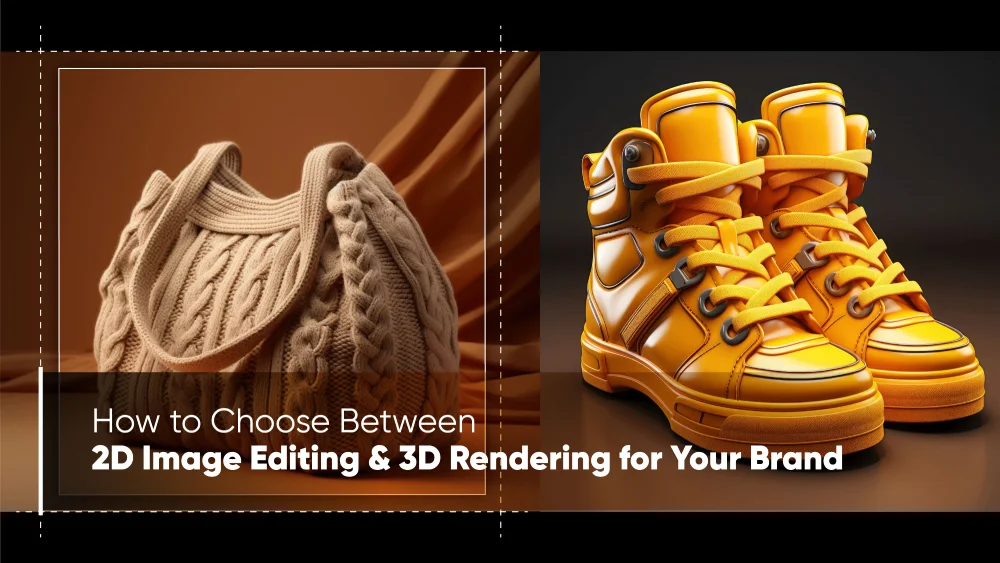If you’ve ever tried online shopping, you must be familiar with product images. Starting from small ecommerce businesses all the way to retail giants, every business uses product visualizations to better sell their product these days.
With the advancement of technology, product imagery has also reached another level. Gone are the days where only low quality 2D images are being used to sell products. The product images that you can see nowadays are sharp, crisp, well lit and composed, as if they were shot using professional grade studio equipment.
On top of that, the introduction of 3D imagery has also started to occupy the product visual industry. As 3D modelling and rendering technologies become more accessible to the general masses, more and more businesses have started using these technologies to further enhance their product photos.
In this article, we’ll go over exactly what 2D and 3D imagery are, how they differ from each other, their individual benefits, and so much more. Stick around, cause this article just might help you transform your product photography skills.
What is 2D Image Editing?
Although almost everybody knows about 2d visualization, let's still go over the basics. A 2D image or a 2 dimensional image is an image that only exists on a 2 dimensional plane. Simply put, a 2D image has only length and width but no height.
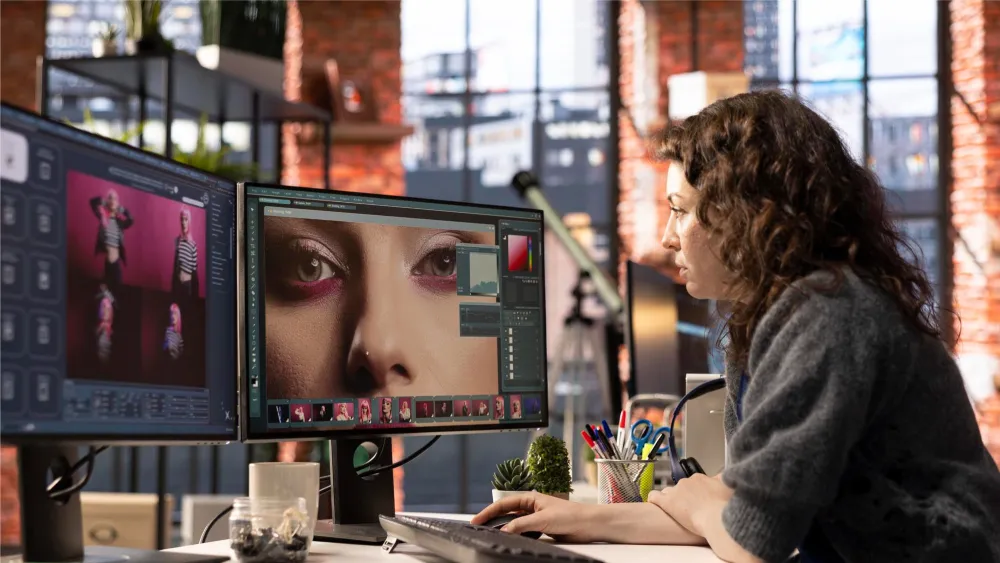
Think of drawing anything on a piece of paper. Because it lies on a 2D plane, you can only measure it from 2 perspectives, namely length and width. The same goes for 2D images that you see on your phone or computer.
When it comes to editing, 2D image editing simply means altering images on a computer or a similar hardware. 2D editing allows you to crop images, cut out undesired parts, change the color or the color temperatures on pictures to indicate a different mood or different levels of brightness and contrast, etc.
You can also draw shapes, add text, or erase flaws like blemishes. Layers let you work on different parts of the image separately, like stacking papers. It's fun and creative, letting you turn plain photos into cool art or fix mistakes to make them look perfect!
What is 3D Rendering?
3D means three-dimensional, describing objects with length, width, and height, unlike flat 2D images. Think of a real-world object like a ball vs. a picture of a ball. The picture only shows a certain angle, whereas the actual object has depth and different details you can see from different angles.
These days, the most common software used for creating objects in 3D is Blender or Maya. Basically, you start with a solid shape and then curve away at it like you would in real life with clay. The software contains advanced features that can help you expedite the creation process.
Once you have a shape ready, you can apply textures or details that will show up on the surface of the object when rendered.
Once you have a working model, you can set up the process for lighting and coloring. The software enables you to set up virtual lights in any location near to the object you're modelling to give it contrasting light and shadow areas.
Animation features are also very common, through which you can make your created objects move or transition into other sequences. Using all the aforementioned functionalities, you can create realistic assets very easily.
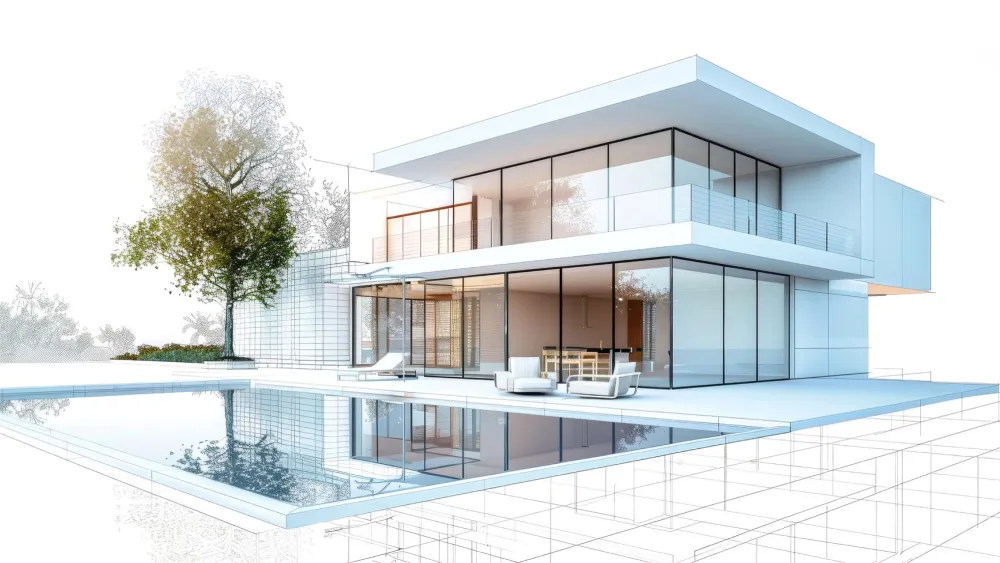
3D rendering is basically the output you get when you apply all the lighting, shadows, texturing, and other effects to your 3D model. The output can be a 2D image, a 3D image (that can be rotated around), or even a video.
Once you select these effects on software like Maya or Blender. Then, you can simply click to render, at which point the software applies the effect on your 3D model and generates an output. Rendering is used to get the final product that you usually see in movies, games, or any other animated media.
Depending on the extent or level of detail you are adding, 3D rendering can be a time-consuming process. Depending on your computer's processing capabilities, this time can be more shortened.
Key Differences Between 2D and 3D
While a 2D image only contains 2 dimensions (length and width), a 3D image consists of an additional dimension commonly known as height. Think of a cartoon character on paper, it looks the same from any angle. However, if you were to add a 3rd dimension to those characters, you'd be able to rotate it around and see it from any angle you desire.
These differences translate over even when it comes to editing. 2D image editing mostly involved adjusting colors and small-scale manipulations such as cropping, erasing, and adding elements such as text or visuals. 3D editing, on the other hand, involves digitally sculpting away at a model and then adding real-world elements such as texture, lighting, shadows, etc.
2D editing is most commonly seen in still images, social media posts, posters, flyers, etc. On the other hand, 3D is more prevalent in the live action movie and game development industries.
Benefits of 2D Image Editing for Your Brand
From a brand perspective, making products more visually appealing and attractive is very important. One of the easiest ways to do this is to simply incorporate 2D image editing to your product photos. Using 2D editing tools such as Adobe Photoshop allows brands to make interesting designs for not only their products, but also their logos, social media posts and other kind of media.
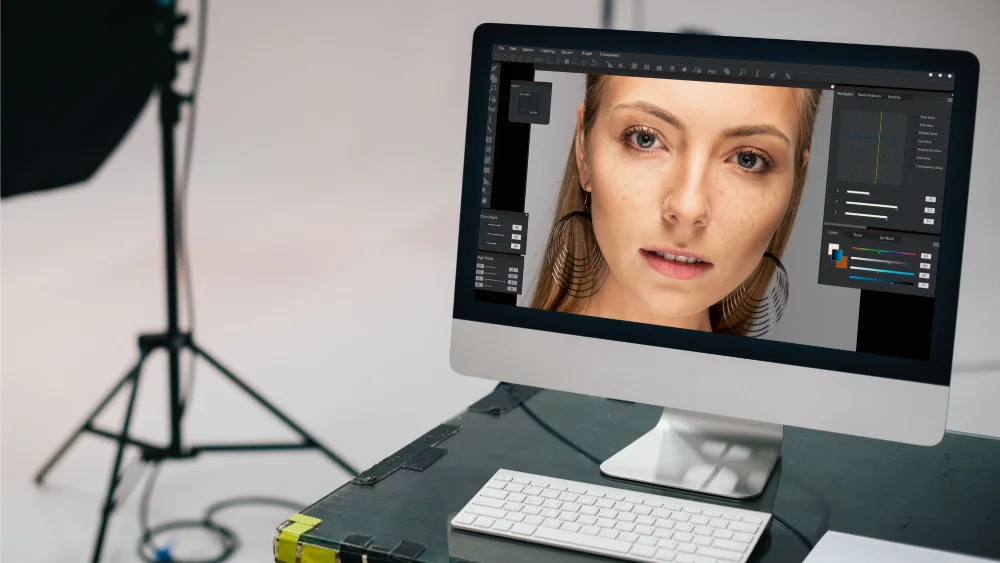
You may think that using these tools or conducting 2D image editing is a very complex and difficult process. However, that is absolutely false. These tools are very easy to learn to use, and often there are shortcuts or presets that take care of basic retouching or editing needs.
To give some examples, common 2D editing examples include increasing the brightness of an image so that the product 'pops' more and does a better job at drawing the viewer's attention. In addition to this, 2D editing is much cheaper and quicker, which is essential for small and growing businesses.
Even though 2D image editing is more affordable, it provides a wide range of versatility at a low price. You can come up with a set of visuals or colors as the theme of your company or brand. Subsequently, you can use the same visuals for different media, including cards, websites, packaging, etc.
This flexibility means brands can quickly adapt visuals for different campaigns or platforms, like resizing a graphic for Instagram or a billboard. Unlike 3D, 2D editing is faster, letting brands meet tight deadlines for marketing.
Finally, 2D is also widely accessible, with many free or affordable tools available. By creating clean, engaging visuals, 2D image editing helps brands connect with customers, boost sales, and build trust in a competitive market.
Benefits of 3D Rendering for Your Brand
When it comes to 3D rendering, brands start exploring a completely new way of visualizing their products. While 2D editing focuses on enhancing images through manipulating their different features, 3D rendering focuses on building a lifelike version of the product on digital platforms. Moreover, brands can generate 3D models of environments and characters that can complement your product visuals in a realistic way.
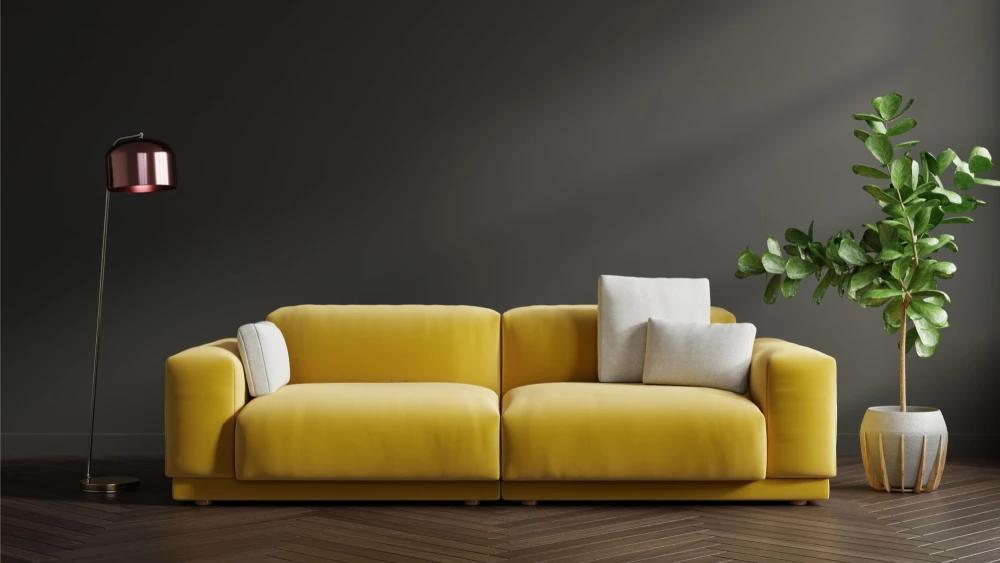
Compared to 2D, 3D is able to show any object from multiple angles under any kind of lighting. This added advantage allows brands to make their product 3d visuals more detailed and immersive. The added bit of realism to the visuals makes the viewers more eager about the products.
Compared to 2D drawings, 3D imaging can also be highly versatile. This is because once created, 3D models can be used again and again for whatever purpose needed. Whether it be close up images for ecommerce photos, animations for video advertisements, or an interactable asset for virtual reality, a 3D model can be used for infinite purposes.
This means that brands can often do this in order to minimize their costs while maximizing their returns. Often times small and growing brands in fashion, retail or even tech struggle with investing on product visualization while still wanting their product to stand out.
In these industries where detailed visuals drive sales, 3D rendering can be a valuable asset for brands who are looking to stand out in a highly competitive market.
How to Choose Between 2D and 3D for Your Brand?
From the information you've read here so far, you already know that both 2D and 3D imaging have their own unique and distinct set of advantages and disadvantages. At the end of the day, whether 2D imaging or 3D rendering is best for you depends on a few common factors.
These factors your include what the ultimate goal of your brand is, who you are making the content for and finally how much resource you have at your disposal. When you consider all these factors, you should clearly be able to decide which between 2D and 3D is best for you.
2D imaging is most suitable if you want to create flat visuals such as logos, PR graphics, or even posters. This is because these outputs cost very little while also taking up small amounts of time. Technically, you could create these 2D visuals completely by hand without the help of a device.
The quick turnaround time, combined with the relatively cheaper costs, makes 2D imaging an attractive visual content option for a lot of brands.
On the other hand, although 3D renders are relatively a lot more immersive and detailed, it requires a lot more time and money to generate such type of visual content. For brands in established industries with high budgets, such as gaming, tech, entertainment, etc., this technology is of immense value.
This is because the market for these industries is more likely to be convinced by seeing more detailed and immersive visual content.
You can animate 3D images for videos or use them in VR (virtual reality). They are interesting, but they take a lot of time and money. They need skilled designers and powerful computers, so they're better for well-known brands with big budgets that want high-quality, eye-catching images.
You should also think about who your business is for. If they're on social media, 2D graphics are easy to take in. For tech-savvy or high-end markets, 3D's realism can make people trust it and get excited.
You should also think about how reusable it is.
In the end, it all comes down to what you're selling, who you're selling it to, and what you and they want most. Pick 2D for speed, cost, and ease, or 3D for depth, interactivity, and wow factor. You can also use both 2D and 3D together, with 2D for everyday posts and 3D for big product launches to get the best of both worlds.
Future Trends in 2D and 3D Design
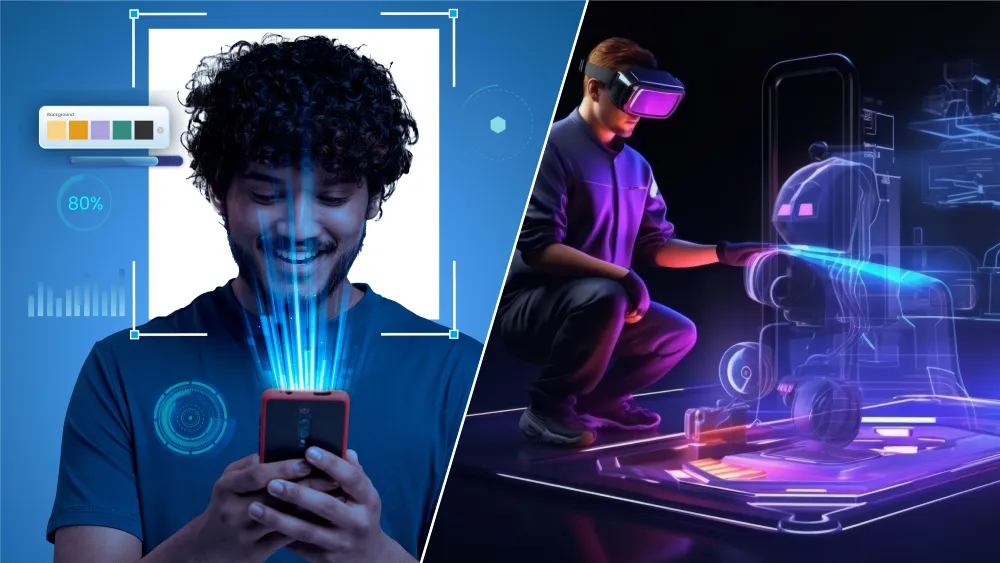
2D Design Future Trends
- AI-Powered Editing: These days there are many software available which easily allow you to automate task like removing background (Retouched.ai), increasing or decreasing brightness or contrast, adding shadows, etc. This is a very easy way to save both time and money for all levels of professionals.
- Minimalist Aesthetics: The recent popularity of minimalism has made clean and simple designs more popular to consumers. This means bold colors and clear fonts will be more attractive, making logos and ads easy to comprehend.
- Motion Graphics: Video editing tools can be used to create simplistic text or image animations that can be just as immersive as 3D while taking up a lot less time and money.
- Augmented Reality (AR) Integration: 2D designs will blend with AR, letting users see posters or packaging come alive through phone apps. As Augmented Reality-based displays sit on 2D planes, it is possible to incorporate 2D imaging for animations and similar sequences in AR.
- Eco-Friendly Designs: The lower the amount of resources used to create the visuals, the lower the carbon footprint and pollution. As a result of this, 2D is the obvious eco-friendly choice.
- Personalized Graphics: As the cost of 2D imaging is significantly lower, brands can re-allocate that saved budget towards making their ads highly customized to individual needs.
These trends make 2D design faster, more interactive, and eco-conscious, perfect for brands wanting quick, impactful visuals.
3D Design Future Trends
- Real-Time Rendering: In recent times, extensive research and development have taken place in the field of CGI and VFX. As a result, there are technologies like Unreal Engine which are capable of generating 3D environments and visuals in mere minutes.
- Virtual Reality (VR) Growth: With 3D content creation becoming faster and cheaper with improved technology, Virtual Reality (VR) has become a newfound avenue for brands to display their products. Customers can now explore or even try on products using VR.
- AI-Driven 3D Modeling: The higher the involvement, the less human involvement there is in 3D content creation. And the less the degree of human input, the quicker the generation of 3D objects like Holosnap.
- 3D Printing Integration: 3D printing has experienced significant improvement in the recent years. It has transformed itself into a full-fledged product manufacturing industry from what used to be a hobby for creative professionals.
- Metaverse Expansion: Social media platforms have started investing in their own proprietary virtual reality platforms where users can interact with each other as well as products placed by brands. Such a platform is the Metaverse, introduced by Meta.
- Holographic Displays: Industries such as tourism and entertainment have long been fiddling with holographic display technology. Advances in 3D generation will enable cheaper content creation for such displays.
Frequently Asked Questions
What is the difference between 2D and 3D image editing?
Think of editing 2D images like correcting a drawing or a painting on a piece of paper; all the adjustments or changes you're making take place on a 2D surface. Most of 2D image editing entails adjusting colors, adding effects or texts, cropping, or transposing one image onto another, etc.
3D image editing, on the other hand, is like working with a sculpture or pottery. In addition to everything you do in 2D editing, you also get to work on the shape of the object itself. 2D is simpler and faster, whereas 3D is detailed and shows multiple perspectives.
Which is better for branding: 2D vs 3D?
It all comes down to what your brand wants to achieve, combined with what kind of resources you have. 2D is more preferable for low investment, quick visuals like social media posts, whereas 3D will yield more success for immersive visual solutions such as 3d product visualization. If your needs are simple, easy, and cheap, go for 2D. If you want full immersion and budget and time are not issues, 3D is the way to go.
Can 3D rendering replace 2D image editing?
As said above, the quick, easy, and cheap nature of 2D imaging makes it almost irreplaceable. With a little bit of skill and expertise, you can even create your own 2D visuals, which would minimize your cost even further.
Although 3D imaging is there to serve a more specific and niche purpose, brands are considering replacing some of their 2D visual materials with 3D content. So far, the most effective solution seems to be a healthy combination of both.
How much does 3D rendering cost compared to 2D editing?
It comes as no surprise that 3D rendering comes at a much higher price compared to similar services in 2D. As said earlier, the simple and straightforward nature of 2D editing means that it should cost at most $5-$20 per image, depending on the difficulty. On the other hand, 3D rendering costs for a single asset can go up into the thousands, even if the object is large and complex enough.
What industries benefit most from 3D rendering?
Industries like gaming, film, architecture, automotive, and product design benefit most from 3D rendering. 3D rendering also involves creating realistic visuals for video games, movie animations, building models, car prototypes, or product ads. In recent years, the fashion and retail industry has started investing in 3D as well.
What file formats are commonly used in 2D photo editing and 3D rendering?
2D photo editing outputs include JPEG, PNG, PSD (Photoshop), and TIFF. 3D rendering outputs can be of a wide variety, with file types ranging from OBJ, STL, FBX, 3DS, etc. These varied file types indicate that varying types of software may be required to open and edit them.
Is 3D rendering suitable for small businesses?
As mentioned earlier, 3D rendering can be a time-consuming and costly process. Even a simple 3D rendering output can cost more than $50, which is a lot for a single product of a small company. However, if the products in question are premium in nature and the visual detail can make a difference, i.e., luxury jewelry, watches, etc., it might just be worth it to invest the cost.
Do you offer both 2D and 3D services?
Yes. The KOW Company provides a wide range of post-production services that include both 2D image editing and 3D modeling and rendering services.
Conclusion
We understand that choosing between 2D editing and 3D rendering can be a complex process and depends on a multitude of factors. Starting from your marketing budget all the way to who you're trying to market your product to, there are lots of things to consider when making this choice.
If you're in industries like gaming, architecture, or medical research that require highly detailed, multi-perspective, realistic visuals, and budget is not a concern, 3D rendering is the way to go. For industries where margins and profits are most important and customers rarely care about product images, it's better to stick to 2D editing.
However, with technological advancement, we believe that even 3D imaging will become more affordable for everyone at some point. Until that day comes, evaluate your needs and constraints and make a well-educated choice!
That’s all for this time folks. We've tried to encapsulate all aspects of 2D editing vs 3D rendering for you. If you require additional information, check out our blog database for more 2D or 3D specific articles.

